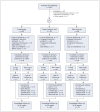Cryotherapy with liquid nitrogen versus topical salicylic acid application for cutaneous warts in primary care: randomized controlled trial
- PMID: 20837684
- PMCID: PMC2952009
- DOI: 10.1503/cmaj.092194
Cryotherapy with liquid nitrogen versus topical salicylic acid application for cutaneous warts in primary care: randomized controlled trial
Abstract
Background: Cryotherapy is widely used for the treatment of cutaneous warts in primary care. However, evidence favours salicylic acid application. We compared the effectiveness of these treatments as well as a wait-and-see approach.
Methods: Consecutive patients with new cutaneous warts were recruited in 30 primary care practices in the Netherlands between May 1, 2006, and Jan. 26, 2007. We randomly allocated eligible patients to one of three groups: cryotherapy with liquid nitrogen every two weeks, self-application of salicylic acid daily or a wait-and-see approach. The primary outcome was the proportion of participants whose warts were all cured at 13 weeks. Analysis was on an intention-to-treat basis. Secondary outcomes included treatment adherence, side effects and treatment satisfaction. Research nurses assessed outcomes during home visits at 4, 13 and 26 weeks.
Results: Of the 250 participants (age 4 to 79 years), 240 were included in the analysis at 13 weeks (loss to follow-up 4%). Cure rates were 39% (95% confidence interval [CI] 29%-51%) in the cryotherapy group, 24% (95% CI 16%-35%) in the salicylic acid group and 16% (95% CI 9.5%-25%) in the wait-and-see group. Differences in effectiveness were most pronounced among participants with common warts (n = 116): cure rates were 49% (95% CI 34%-64%) in the cryotherapy group, 15% (95% CI 7%-30%) in the salicylic acid group and 8% (95% CI 3%-21%) in the wait-and-see group. Cure rates among the participants with plantar warts (n = 124) did not differ significantly between treatment groups.
Interpretation: For common warts, cryotherapy was the most effective therapy in primary care. For plantar warts, we found no clinically relevant difference in effectiveness between cryotherapy, topical application of salicylic acid or a wait-and-see approach after 13 weeks. (ClinicalTrial.gov registration no. ISRCTN42730629).
Figures
Comment in
-
Randomized controlled trial of cryotherapy with liquid nitrogen vs topical salicylic acid vs wait-and-see for cutaneous warts.Arch Dermatol. 2012 Jul;148(7):840-2. doi: 10.1001/archdermatol.2011.2763. Arch Dermatol. 2012. PMID: 22801618 No abstract available.
References
-
- Johnson MT, Roberts J. Skin conditions and related need for medical care among persons 1–74 years. United States, 1971–1974. Vital Health Stat. 1978:i–72. - PubMed
-
- Beliaeva TL. The population incidence of warts [article in Russian] Vestn Dermatol Venerol. 1990;2:55–8. - PubMed
-
- van Haalen FM, Bruggink SC, Gussekloo J, et al. Warts in primary school children: Prevalence and relation with environmental factors. Br J Dermatol. 2009;161:148–52. - PubMed
-
- Massing AM, Epstein WL. Natural history of warts. A two-year study. Arch Dermatol. 1963;87:306–10. - PubMed
Publication types
MeSH terms
Substances
Associated data
LinkOut - more resources
Full Text Sources
Medical

